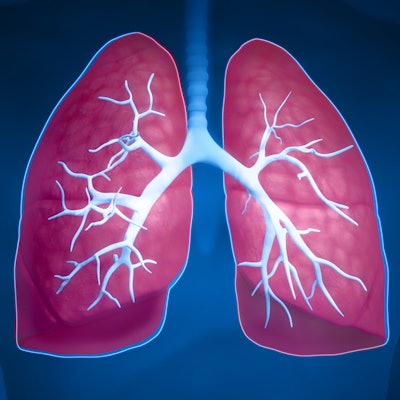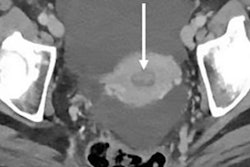
If an incidental lung nodule is present on a CT coronary artery calcium (CAC) scoring scan, how often is that nodule actually detected and worked up? Not as often as one might expect, according to researchers who analyzed the reasons why nodules might be missed in a presentation at RSNA 2017.
The researchers retrospectively examined the cases of patients who underwent cardiac CT and eventually received a diagnosis of lung cancer. After analyzing the cases, they found that physicians either failed to catch or misinterpreted a considerable number of lung lesions that were present on early CT CAC scoring scans.
In addition, there were clinical ramifications to not catching these cancers early: Missed lesions resulted in a postponed diagnosis of lung cancer by more than 13 months in nearly 34% of patients, Dr. Young Joo Suh of Yonsei University College of Medicine in Seoul told RSNA 2017 attendees. Fortunately, she also offered some tips for picking up these incidental cancers on CAC scans.
"When scoring calcium on CT, concerns for lung cancer and awareness of common lesion characteristics, such as a solid nodule in the right upper lobe, may help to avoid delayed diagnosis," she said.
What's the holdup?
Coronary artery disease (CAD) and lung cancer share certain key risk factors -- including old age and smoking -- that often enable imaging for one of them to provide insight into the other, according to Suh. For instance, radiologists can use wide field-of-view cardiac CT covering the entire thorax to determine coronary artery calcium levels as well as evaluate lung parenchyma for cancer.
"There have been studies regarding lung cancer detected on cardiac CT, but the necessity of follow-up of pulmonary nodules is controversial," she said. "How about applying calcium scoring CT to detect lung cancer?"
Suh and colleagues started with the cardiac CT scans of more than 20,000 patients at a single institution who received treatment from January 2010 to December 2014. Approximately 1.5% (333) of patients who underwent CT CAC scoring turned out to have lung cancer.
The researchers wanted to focus on why these cancers were missed on CT CAC scoring scans. After excluding patients who had previously received lung cancer surgery, had benign lesions, or did not have their tumors confirmed via biopsy, they arrived at a final cohort of 151 patients with lung cancer. Suh and colleagues reviewed the CT scans of these patients to determine tumor type, size, location, and defining characteristics. They also collected information related to lung cancer mortality and shifts in tumor stage.
"We assessed the stage of lung cancer in two ways: tentative lung cancer stage at the time of CT CAC scoring and lung cancer stage at the time of final diagnosis," Suh said. "We also analyzed whether delayed diagnosis or stage shift occurred between CT and final diagnosis."
They set the cutoff for a delayed diagnosis of lung cancer as diagnosis at 13.7 months after CT CAC scoring, and they classified the causes for delay into five categories:
- Detection error: The radiologist missed the lesion on initial CT CAC scoring.
- Interpretation error: The radiologist spotted a lesion but misinterpreted it as nonmalignant.
- Follow-up for subsolid lesion: The radiologist detected a subsolid lesion on CT CAC scoring that he or she tracked and eventually confirmed as malignant after follow-up.
- No appropriate action: The clinician did not take appropriate action, despite the radiologist correctly identifying a malignant lesion.
- Miscellaneous: There was a false-negative result from biopsy or aspiration.
Errors delay diagnosis
Among the 151 patients with lung cancer, 51 had a delayed diagnosis. The average age of this lung cancer population was 68 years; 60.9% were male, 47.7% were current or former smokers, 8.6% had a family history of lung cancer, and 4% had a family history of CAD.
| Factors delaying diagnosis of lung cancer on CT calcium scoring | ||
| No. of lung cancers with delayed diagnosis | Percentage of lung cancers with delayed diagnosis | |
| Detection error | 26 | 17.2% |
| Interpretation error | 10 | 6.6% |
| Follow-up for subsolid lesion | 10 | 6.6% |
| No appropriate action | 3 | 1.9% |
| Miscellaneous | 2 | 1.2% |
Detection error -- simply missing a lung lesion -- was responsible for more than half of the late diagnoses. Misinterpreting a lung lesion tied for the second most common cause of a delayed diagnosis.
The missed lung cancers most frequently were adenocarcinomas (72.2%), had an average diameter of 2 cm, and appeared in the right upper lobe (29.8%). Though the majority of lesions were stage I (75%) at the time of CT CAC scoring, 15.2% of them progressed to higher stages by the time of final diagnosis.
This stage shift is one of the critical consequences of a delayed diagnosis, Suh said. Time to diagnosis was a statistically significant predictor of stage shift, which, in turn, was associated with lung cancer-related mortality. Age and the lesion being solid, unresectable, or larger than 3 cm were also associated with increased mortality.
"Appropriate follow-up or management should be emphasized when large solid nodules are detected on CAC scoring CT of old-age patients," she said.




















